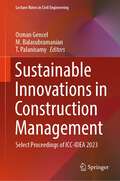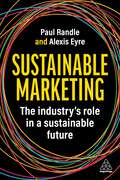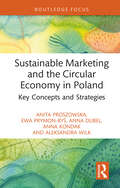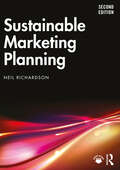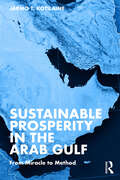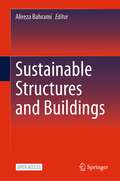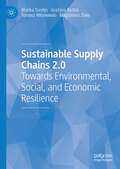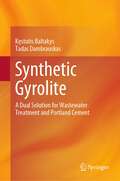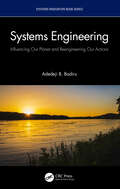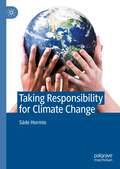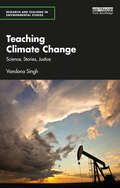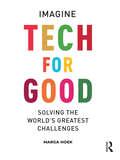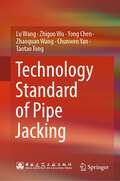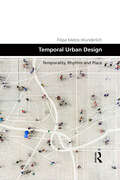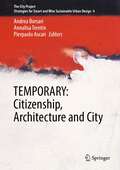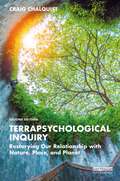- Table View
- List View
Sustainable Innovations in Construction Management: Select Proceedings of ICC-IDEA 2023 (Lecture Notes in Civil Engineering #388)
by Osman Gencel M. Balasubramanian T. PalanisamyThis book presents the select proceedings of International Conference on Civil Engineering: Innovative Development in Engineering Advances (ICC IDEA 2023). This book covers the latest research in the areas of construction engineering and management, urban planning and design, building energy conservation and green architecture, materials science and engineering, innovation in construction materials, and information technology in civil engineering. The book is useful for researchers and professionals in civil engineering.
Sustainable Marketing: The Industry’s Role in a Sustainable Future
by Paul Randle Alexis EyreBecoming a sustainable marketer is no longer an optional extra. Sustainability has become a necessity for the future, but do you feel confident delivering on this for your clients and customers?Sustainable Marketing is a blueprint for embedding sustainability at the heart of marketing. Exposing the disturbing reality of marketing's current relationship with many of our environmental and societal problems, it challenges the traditional role of marketing, its cultural norms and gross inefficiency. It goes on to present a compelling vision for change and a practical guide for marketing professionals, equipping them with the mindset and tools to transform their daily work and the industry as a whole, into a force for good.This is the perfect guide for marketing and sustainability professionals working through their company's sustainable transformation whilst trying to avoid the pitfalls of greenwashing and carbon myopia. Written by experts who apply their unique framework to the issue, this book takes what may feel like an insurmountable challenge and breaks it down, giving in-depth advice and providing real-world success stories from companies of all sizes including Tony's Chocolonely, The Onlii and AkzoNobel.
Sustainable Marketing: The Industry’s Role in a Sustainable Future
by Paul Randle Alexis EyreBecoming a sustainable marketer is no longer an optional extra. Sustainability has become a necessity for the future, but do you feel confident delivering on this for your clients and customers?Sustainable Marketing is a blueprint for embedding sustainability at the heart of marketing. Exposing the disturbing reality of marketing's current relationship with many of our environmental and societal problems, it challenges the traditional role of marketing, its cultural norms and gross inefficiency. It goes on to present a compelling vision for change and a practical guide for marketing professionals, equipping them with the mindset and tools to transform their daily work and the industry as a whole, into a force for good.This is the perfect guide for marketing and sustainability professionals working through their company's sustainable transformation whilst trying to avoid the pitfalls of greenwashing and carbon myopia. Written by experts who apply their unique framework to the issue, this book takes what may feel like an insurmountable challenge and breaks it down, giving in-depth advice and providing real-world success stories from companies of all sizes including Tony's Chocolonely, The Onlii and AkzoNobel.
Sustainable Marketing and the Circular Economy in Poland: Key Concepts and Strategies (Routledge Focus on Environment and Sustainability)
by Anita Proszowska Ewa Prymon-Ryś Anna Dubel Anna Kondak Aleksandra WilkSustainable Marketing and the Circular Economy in Poland outlines the specific challenges around formulating an organisation's marketing strategy in line with the circular economy (CE) framework.This book helps to solve the problem of ineffective pro-environmental programmes and marketing tools, which are currently used by enterprises to make their activities more sustainable. The authors identify key concepts and strategies of sustainable marketing to highlight the trends and development directions of marketing activities of modern enterprises. Focussing on Poland as a central case study, the book is illustrated with examples of organisations that are implementing sustainable marketing activities that are compatible with the CE model. It also presents the results of studies which examined the pro-environmental marketing efforts of small- and medium-sized enterprises, non-governmental organisations and other actors in Poland. To conclude, the authors put forward recommendations for CE network stakeholders regarding sustainable marketing management, focussing specifically on how to avoid accusations of greenwashing and other unethical organisational behaviour.This book will be of great interest to students and scholars of green marketing, sustainable business and the CE, as well as entrepreneurs and business professionals looking to formulate sustainable marketing strategies.
Sustainable Marketing and the Circular Economy in Poland: Key Concepts and Strategies (Routledge Focus on Environment and Sustainability)
by Anita Proszowska Ewa Prymon-Ryś Anna Dubel Anna Kondak Aleksandra WilkSustainable Marketing and the Circular Economy in Poland outlines the specific challenges around formulating an organisation's marketing strategy in line with the circular economy (CE) framework.This book helps to solve the problem of ineffective pro-environmental programmes and marketing tools, which are currently used by enterprises to make their activities more sustainable. The authors identify key concepts and strategies of sustainable marketing to highlight the trends and development directions of marketing activities of modern enterprises. Focussing on Poland as a central case study, the book is illustrated with examples of organisations that are implementing sustainable marketing activities that are compatible with the CE model. It also presents the results of studies which examined the pro-environmental marketing efforts of small- and medium-sized enterprises, non-governmental organisations and other actors in Poland. To conclude, the authors put forward recommendations for CE network stakeholders regarding sustainable marketing management, focussing specifically on how to avoid accusations of greenwashing and other unethical organisational behaviour.This book will be of great interest to students and scholars of green marketing, sustainable business and the CE, as well as entrepreneurs and business professionals looking to formulate sustainable marketing strategies.
Sustainable Marketing Planning
by Neil RichardsonThis book provides practical insights, tools and frameworks to help readers produce tactically and strategically appropriate marketing plans.Showing how to embed sustainability in these plans, students will be shown how to implement changes while being encouraged to reflect on why they are needed. The text reflects on contemporary themes that impact on sustainable marketing planning, including consumer behaviour, entrepreneurialism, internal marketing, services, international marketing, event management and digital marketing. The second edition has been fully updated with a greater focus on the issues surrounding sustainability, including the environmental challenges facing businesses, sustainable accreditation and integrating the UN SDGs. It provides background on the value discourses that underpin sustainability, incorporates new examples and case studies from broader regions around the world and introduces TBL-based loyalty. Full of tools and frameworks to improve comprehension, including chapter-by-chapter learning outcomes, summaries, exercises, applied activities and mini case studies, it bridges the gap between theory and practice effectively and accessibly.Presenting contemporary themes and challenges at the cutting edge of business research and practice, this book provides core reading for advanced undergraduate and postgraduate students of sustainable marketing, marketing planning and marketing strategy, as well as professionals seeking to improve the competitive advantage of their organisations.Online resources for the use of instructors include PowerPoint lecture slides and a multiple choice questions section.
Sustainable Marketing Planning
by Neil RichardsonThis book provides practical insights, tools and frameworks to help readers produce tactically and strategically appropriate marketing plans.Showing how to embed sustainability in these plans, students will be shown how to implement changes while being encouraged to reflect on why they are needed. The text reflects on contemporary themes that impact on sustainable marketing planning, including consumer behaviour, entrepreneurialism, internal marketing, services, international marketing, event management and digital marketing. The second edition has been fully updated with a greater focus on the issues surrounding sustainability, including the environmental challenges facing businesses, sustainable accreditation and integrating the UN SDGs. It provides background on the value discourses that underpin sustainability, incorporates new examples and case studies from broader regions around the world and introduces TBL-based loyalty. Full of tools and frameworks to improve comprehension, including chapter-by-chapter learning outcomes, summaries, exercises, applied activities and mini case studies, it bridges the gap between theory and practice effectively and accessibly.Presenting contemporary themes and challenges at the cutting edge of business research and practice, this book provides core reading for advanced undergraduate and postgraduate students of sustainable marketing, marketing planning and marketing strategy, as well as professionals seeking to improve the competitive advantage of their organisations.Online resources for the use of instructors include PowerPoint lecture slides and a multiple choice questions section.
Sustainable Prosperity in the Arab Gulf: From Miracle to Method
by Jarmo T. KotilaineTracing the development journey of the Arabian Gulf region with a forward-looking perspective, this book describes how a combination of good fortune, creative experimentation, and determination has enabled the region to achieve prosperity. Today, the Arabian Gulf is well positioned to assume a pivotal role in the new global order. Forced to balance an extreme climate and acute resource constraints, but also an exceptional location, the region’s progress and prosperity have historically been precarious and vulnerable to external shocks. Efforts to transcend resource dependency have typically involved proactive attempts to enable other economic activities. This book argues that, while conventional economic diversification is making headway, the Gulf region is in fact amidst a far more holistic transformation that positions it for a pivotal role in the emerging multipolar global order. It now offers globally competitive regulations and world-class infrastructure at the heart of the Old World, flanked by two fast-growing continents. It has become the hub of choice for a growing share of inter-continental flows of people, trade, and capital, and has established strong economic ties in all directions. This book shows how, despite many risks and challenges, the region possesses the forward-looking vision and necessary resilience that can finally liberate it from its long-standing "resource curse" and a development paradigm that looks likely to provide the foundation for sustained well-being in the decades ahead. The scope and rigor of the book make it suitable as a reference on the Arabian Gulf and for those interested in global affairs and economic development, as well as policymakers and the business community.
Sustainable Prosperity in the Arab Gulf: From Miracle to Method
by Jarmo T. KotilaineTracing the development journey of the Arabian Gulf region with a forward-looking perspective, this book describes how a combination of good fortune, creative experimentation, and determination has enabled the region to achieve prosperity. Today, the Arabian Gulf is well positioned to assume a pivotal role in the new global order. Forced to balance an extreme climate and acute resource constraints, but also an exceptional location, the region’s progress and prosperity have historically been precarious and vulnerable to external shocks. Efforts to transcend resource dependency have typically involved proactive attempts to enable other economic activities. This book argues that, while conventional economic diversification is making headway, the Gulf region is in fact amidst a far more holistic transformation that positions it for a pivotal role in the emerging multipolar global order. It now offers globally competitive regulations and world-class infrastructure at the heart of the Old World, flanked by two fast-growing continents. It has become the hub of choice for a growing share of inter-continental flows of people, trade, and capital, and has established strong economic ties in all directions. This book shows how, despite many risks and challenges, the region possesses the forward-looking vision and necessary resilience that can finally liberate it from its long-standing "resource curse" and a development paradigm that looks likely to provide the foundation for sustained well-being in the decades ahead. The scope and rigor of the book make it suitable as a reference on the Arabian Gulf and for those interested in global affairs and economic development, as well as policymakers and the business community.
Sustainable Structures and Buildings
by Alireza BahramiThis open access book includes detail on various structures, buildings, and building materials from different structural and sustainability perspectives. It describes how the building industry is vital for the achievement of the sustainable development goals, namely, economic growth, social progress, and the effective protection of the environment. The aim of this collection is to foster the design and construction of sustainable structures and buildings to reduce the environmental load, connect with the environment, and benefit the health of occupants. Presenting the knowledge, trends, and developments from a group of contributors in the field working with different kinds of structures, structural components, buildings, and building materials, the book is ideal for practitioners working in commercial settings, as well as engineering students and researchers concerned with sustainability issues.
Sustainable Supply Chains 2.0: Towards Environmental, Social, and Economic Resilience
by Blanka Tundys Grażyna Kędzia Tomasz Wiśniewski Magdalena ZiołoSustainable supply chains are one of the development trends of modern business strategies. They are a response to economic challenges and trends, while at the same time being a creator of value and competitive advantage. This book identifies environmental, social, and economic issues not only as the basis for configuring a sustainable supply chain, but also as important determinants of supply chain resilience. By presenting a new model, Sustainable Supply Chain 2.0, this book combines academic theory with practical demonstration on how to build resilient supply chains that implement the principles of sustainable development. It will be of great interest to students of management, supply chain and logistics studies, as well as researchers in the field and business practitioners, including supply chain managers.
Synthetic Gyrolite: A Dual Solution for Wastewater Treatment and Portland Cement
by Kęstutis Baltakys Tadas DambrauskasThis book explores the topic of gyrolite and calcium silicate hydrates, focusing on their potential applications in wastewater purification and as additives in ordinary Portland cement. Divided into five chapters, the book provides a comprehensive description of calcium silicate hydrates and addresses challenges in reusing solid waste. It also covers the synthesis and application of gyrolite, offering technological recommendations for future studies. The results presented are supported by instrumental analysis techniques and thermodynamic calculations, allowing readers to delve into inorganic chemistry and materials characterization. The book is suitable for both researchers and students interested in chemistry and materials characterization, offering valuable insights and guidance in the field.
Systems Engineering: Influencing Our Planet and Reengineering Our Actions (Systems Innovation Book Series)
by Adedeji B. BadiruPeople want to create a better world and planet; however, where, and how to start remains the question. Systems Engineering’s problem-solving methodology can help with its ability to answer multiple questions along with connecting actions and impacts. This book uses the Systems Engineering problem-solving methodology to frame how each answer impacts the planet when multiple actions are strung together no matter where they take place. Systems Engineering: Influencing Our Planet and Reengineering Our Actions illustrates a hierarchical Systems Engineering view of the world with each individual in mind as a link in the chain. It uses an Industrial Engineering framework for action implementations and identifies humans’ interconnected actions. The book discusses the implementation of the Systems Engineering problem-solving methodology and leverages existing concepts of environmental sustainability. A template is present for personal actions for environment social responsibility using a Systems Engineering problem-solving approach and focuses on the foundational use of the trademarked DEJI Systems Model® for action design, evaluation, justification, and integration. This book is a perfect read for all academic disciplines and all engineering fields, as well as business and management fields. It reminds us of the Environmental Foundation of NAE’s 14 Grand Challenges and the part we can play.
Systems Engineering: Influencing Our Planet and Reengineering Our Actions (Systems Innovation Book Series)
by Adedeji B. BadiruPeople want to create a better world and planet; however, where, and how to start remains the question. Systems Engineering’s problem-solving methodology can help with its ability to answer multiple questions along with connecting actions and impacts. This book uses the Systems Engineering problem-solving methodology to frame how each answer impacts the planet when multiple actions are strung together no matter where they take place. Systems Engineering: Influencing Our Planet and Reengineering Our Actions illustrates a hierarchical Systems Engineering view of the world with each individual in mind as a link in the chain. It uses an Industrial Engineering framework for action implementations and identifies humans’ interconnected actions. The book discusses the implementation of the Systems Engineering problem-solving methodology and leverages existing concepts of environmental sustainability. A template is present for personal actions for environment social responsibility using a Systems Engineering problem-solving approach and focuses on the foundational use of the trademarked DEJI Systems Model® for action design, evaluation, justification, and integration. This book is a perfect read for all academic disciplines and all engineering fields, as well as business and management fields. It reminds us of the Environmental Foundation of NAE’s 14 Grand Challenges and the part we can play.
Taking Responsibility for Climate Change
by Säde HormioThis book proposes that it is not only states and international bodies that have a responsibility to take action toward mitigating climate change. Other collective agents, such as corporations, need to also come onboard. Additionally, the book argues that climate change is not solely a problem for collective agents, but also for individuals, as they are members of collectives and groups of several kinds. Therefore, framing climate change responsibility exclusively from either the collective or the individual perspective leaves out something crucial: how we all are influenced by the collectives we belong to and how, in turn, collectives are influenced by individuals. The focus of the book is on areas of climate change responsibility that are often left out of the picture or get too little attention in climate ethics, such as carbon inequality within countries. But why should any theoretical arguments about normative issues matter when we have a real-life climate crisis on our hands? Säde Hormio argues that ethical arguments have an important role in setting climate policy: they can highlight what values are at stake and help ground normative arguments in public deliberations.
Teaching Climate Change: Science, Stories, Justice (Research and Teaching in Environmental Studies)
by Vandana SinghTeaching Climate Change: Science, Stories, Justice shows educators how climate change can be taught from any disciplinary perspective and in a transdisciplinary way, drawing on examples from the author's own classroom. The book sets out a radical vision for climate pedagogy, introducing an innovative framework in which the scientific essentials of climate change are scaffolded via three transdisciplinary meta-concepts: Balance/Imbalance, Critical Thresholds and Complex Interconnections. Author Vandana Singh grounds this theory in practice, drawing on examples from her own classroom to provide implementable ideas for educators, and to demonstrate how climate change can be taught from any disciplinary perspective in a transdisciplinary way. The book also explores the barriers to effective climate education at a macro level, focusing on issues such as climate misinformation/misconception, the exclusion of social and ethical concerns and a focus on technofixes. Singh uses this information to identify four key dimensions for an effective climate pedagogy, in which issues of justice are central: scientific-technological, the transdisciplinary, the epistemological and the psychosocial. This approach is broad and flexible enough to be adapted to different classrooms and contexts. Bridging the social and natural sciences, this book will be an essential resource for all climate change educators practicing in both formal and informal settings, as well as for community climate activists.
Teaching Climate Change: Science, Stories, Justice (Research and Teaching in Environmental Studies)
by Vandana SinghTeaching Climate Change: Science, Stories, Justice shows educators how climate change can be taught from any disciplinary perspective and in a transdisciplinary way, drawing on examples from the author's own classroom. The book sets out a radical vision for climate pedagogy, introducing an innovative framework in which the scientific essentials of climate change are scaffolded via three transdisciplinary meta-concepts: Balance/Imbalance, Critical Thresholds and Complex Interconnections. Author Vandana Singh grounds this theory in practice, drawing on examples from her own classroom to provide implementable ideas for educators, and to demonstrate how climate change can be taught from any disciplinary perspective in a transdisciplinary way. The book also explores the barriers to effective climate education at a macro level, focusing on issues such as climate misinformation/misconception, the exclusion of social and ethical concerns and a focus on technofixes. Singh uses this information to identify four key dimensions for an effective climate pedagogy, in which issues of justice are central: scientific-technological, the transdisciplinary, the epistemological and the psychosocial. This approach is broad and flexible enough to be adapted to different classrooms and contexts. Bridging the social and natural sciences, this book will be an essential resource for all climate change educators practicing in both formal and informal settings, as well as for community climate activists.
Tech For Good: Imagine Solving the World’s Greatest Challenges
by Marga HoekTech For Good reveals how Fourth Industrial Revolution technologies will help solve the world’s greatest challenges like climate change, biodiversity loss, inequality, and poverty. Tech For Good presents a unique perspective on how business can successfully apply advanced technologies in a purpose-driven manner while unlocking new markets and seizing business opportunities. Packed with 75 real-life business cases of companies from all over the world, this inspiring book unfolds a compelling narrative about how businesses commercially synergize technology and sustainability. The purpose of this book is to imagine the unprecedented possibilities advanced technologies offer business to drive sustainable growth. Tech for Good will be vital for realizing our Global Goals.
Tech For Good: Imagine Solving the World’s Greatest Challenges
by Marga HoekTech For Good reveals how Fourth Industrial Revolution technologies will help solve the world’s greatest challenges like climate change, biodiversity loss, inequality, and poverty. Tech For Good presents a unique perspective on how business can successfully apply advanced technologies in a purpose-driven manner while unlocking new markets and seizing business opportunities. Packed with 75 real-life business cases of companies from all over the world, this inspiring book unfolds a compelling narrative about how businesses commercially synergize technology and sustainability. The purpose of this book is to imagine the unprecedented possibilities advanced technologies offer business to drive sustainable growth. Tech for Good will be vital for realizing our Global Goals.
Technology Standard of Pipe Jacking
by Lu Wang Zhiguo Wu Yong Chen Zhaoquan Wang Chunwen Yan Taotao TongThis book summarizes the technical method and construction process of pipe jacking. It has a total of 17 chapters and one appendix. It includes how to prepare the pipe jacking construction, how to choose the pipe and equipment for jacking, how to choose the engineering environment, how to do the geological survey before jacking, how to design the working pit, what's the procedure of pipe jacking, how to do the measurement and monitoring during jacking, how to do the treatment and acceptance after jacking, and so on. Appendix contains reference tables for pipe jacking archives, which might aid readers in understanding the book's content. This book's language is simple to read, and it has a wealth of graphics. Even those without a foundational understanding of pipe jacking could read and comprehend it with ease. This regulation could be the fundamental discipline for pipeline jacking projects. It is the important basis and criterion for the design, construction, management, inspection, and acceptance of pipeline jacking.
Temporal Urban Design: Temporality, Rhythm and Place (Design and the Built Environment)
by Filipa Matos WunderlichTemporal Urban Design: Temporality, Rhythm and Place examines an alternative design approach, focusing on the temporal aesthetics of urban places and the importance of the sense of time and rhythm in the urban environment. The book departs from concerns on the acceleration of cities, its impact on the urban quality of life and the liveability of urban spaces, and questions on what influences the sense of time, and how it expresses itself in the urban environment. From here, it poses the questions: what time is this place and how do we design for it? It offers a new aesthetic perspective akin to music, brings forward the methodological framework of urban place-rhythmanalysis, and explores principles and modes of practice towards better temporal design quality in our cities. The book demonstrates that notions of time have long been intrinsic to planning and urban design research agendas and, whilst learning from philosophy, urban critical theory, and both the natural and social sciences debate on time, it argues for a shift in perspective towards the design of everyday urban time and place timescapes. Overall, the book explores the value of the everyday sense of time and rhythmicity in the urban environment, and discusses how urban designers can understand, analyse and ultimately play a role in the creation of temporally unique, both sensorial and affective, places in the city. The book will be of interest to urban planners, designers, landscape architects and architects, as well as urban geographers, and all those researching within these disciplines. It will also interest students of planning, urban design, architecture, urban studies, and of urban planning and design theory.
Temporal Urban Design: Temporality, Rhythm and Place (Design and the Built Environment)
by Filipa Matos WunderlichTemporal Urban Design: Temporality, Rhythm and Place examines an alternative design approach, focusing on the temporal aesthetics of urban places and the importance of the sense of time and rhythm in the urban environment. The book departs from concerns on the acceleration of cities, its impact on the urban quality of life and the liveability of urban spaces, and questions on what influences the sense of time, and how it expresses itself in the urban environment. From here, it poses the questions: what time is this place and how do we design for it? It offers a new aesthetic perspective akin to music, brings forward the methodological framework of urban place-rhythmanalysis, and explores principles and modes of practice towards better temporal design quality in our cities. The book demonstrates that notions of time have long been intrinsic to planning and urban design research agendas and, whilst learning from philosophy, urban critical theory, and both the natural and social sciences debate on time, it argues for a shift in perspective towards the design of everyday urban time and place timescapes. Overall, the book explores the value of the everyday sense of time and rhythmicity in the urban environment, and discusses how urban designers can understand, analyse and ultimately play a role in the creation of temporally unique, both sensorial and affective, places in the city. The book will be of interest to urban planners, designers, landscape architects and architects, as well as urban geographers, and all those researching within these disciplines. It will also interest students of planning, urban design, architecture, urban studies, and of urban planning and design theory.
TEMPORARY: Citizenship, Architecture and City (The City Project #4)
by Andrea Borsari Annalisa Trentin Pierpaolo AscariThis book offers a comprehensive overview of forces shaping urban renewal and the sustainable and inclusive transformation of contemporary cities. It discusses temporariness and uncertainty of citizenship, participation, and inclusion, as well as the energy and digital transformation, merging different perspectives, such as the social, philosophical, economic, and architectural ones. Based on revised and extended contributions to the International Congress “TEMPORARY: Citizenship, Architecture and City", held virtually on November 20-21, 2022, from the University of Bologna, this book offers extensive information and a thought-provoking reading to researchers in architecture, anthropology, social and environmental policy, as well as to professionals and policy makers involved in planning the city of the future.
Terrapsychological Inquiry: Restorying Our Relationship with Nature, Place, and Planet
by Craig ChalquistTerrapsychological Inquiry is a path of storied, imaginative research that takes seriously our intense inner responses to the state of the natural world. This place-rooted approach studies, from the standpoint of lived experience, how the world gets into the heart. Oceans and skies, trees and hills, rivers and soils, and even built things like houses, cities, ports, and planes: How do they show up for us inwardly? How do our moods, feelings, and dreams reflect what happens in the world? Terrapsychological Inquiry evolved over a decade of exploration by graduate students, instructors, ceremonialists, workshop leaders and presenters, and other practitioners of embodied creativity to offer an Earth-honoring mode of storied qualitative inquiry, one that transforms all involved from passive spectators of the doings of the world into active, sensitive participants. Learn how to use this methodology of earthly reenchantment in a variety of settings inside and outside academia and by doing so reenter an animate world. This new edition has been revised throughout and offers fresh insights into how Terrapsychological Inquiry, a field with roots in depth psychology, ecopsychology, and Hermetic philosophy, can also be used as an ecospiritual path. Thoroughly updated with a new chapter and added discussion questions and exercises at the end of each chapter, this introduction to an evolving research methodology will be of great interest to students and scholars of environmental psychology, ecotherapy, and environment and sustainability studies more generally.
Terrapsychological Inquiry: Restorying Our Relationship with Nature, Place, and Planet
by Craig ChalquistTerrapsychological Inquiry is a path of storied, imaginative research that takes seriously our intense inner responses to the state of the natural world. This place-rooted approach studies, from the standpoint of lived experience, how the world gets into the heart. Oceans and skies, trees and hills, rivers and soils, and even built things like houses, cities, ports, and planes: How do they show up for us inwardly? How do our moods, feelings, and dreams reflect what happens in the world? Terrapsychological Inquiry evolved over a decade of exploration by graduate students, instructors, ceremonialists, workshop leaders and presenters, and other practitioners of embodied creativity to offer an Earth-honoring mode of storied qualitative inquiry, one that transforms all involved from passive spectators of the doings of the world into active, sensitive participants. Learn how to use this methodology of earthly reenchantment in a variety of settings inside and outside academia and by doing so reenter an animate world. This new edition has been revised throughout and offers fresh insights into how Terrapsychological Inquiry, a field with roots in depth psychology, ecopsychology, and Hermetic philosophy, can also be used as an ecospiritual path. Thoroughly updated with a new chapter and added discussion questions and exercises at the end of each chapter, this introduction to an evolving research methodology will be of great interest to students and scholars of environmental psychology, ecotherapy, and environment and sustainability studies more generally.
